|
|
| home |
| Vito
Acconci interview Elena Carlini |
||||
| Vito
Acconci began his artistic career as a poet and language is still an
important feature of his experimental work, the background against which
he develops his work as a visual artist, a video maker, a body artist,
and a designer of architectural and urban works of art. He has always
worked in New York, where he set up the Acconci Studio, a think-tank
of art and architecture where he collaborates with a group of young
designers, currently producing works of public art for urban and unique
settings such as the Storefront, an art gallery and cultural center
in Manhattan, the Park up Building, a mobile park mounted on
the external wall of Alvaro Siza's Centro Gallego de Arte Contemporanea
in Santiago de Compostela, the island on the river Mur in Graz and the
new Design Store at the Museum für Angewandte Kunst in Vienna. Elena
Carlini interviewed the artist in his studio in Brooklyn. |
||||
| [in italiano] | ELENA
CARLINI: What is the relation between art and architecture in your thoughts
and projects? VITO ACCONCI: Your question is simple but it questions my entire career. At the end of the Sixties, my mind wasn't turned to creating or studying living spaces but rather the space of the body. I concentrated on projects that involved my corporality and which, by ending in me, created the space of the body; at the same time, however, since we're talking about an environment, this entity also needed a place where it could exist. Perhaps, this interest of mine stemmed from Seedbed, which was an attempt to become part of architecture: I wasn't an entity in space anymore, I was part of the room, of the floor, of the environment (1972 Sonnabend Gallery in New York: during the exhibition, Acconci hides underneath a wooden ramp on which the public walks and he masturbates himself while his voice is heard at intervals coming from below, seeking a metaphoric bond with the public, the space of his body and the space of the gallery editor's note).  Vito Acconci. Indirect approaches source: art/tapes from b/w video tape. |
[24jun2002] | ||
| Then
I stopped using my body, my person, because I felt that it was
a form of language that belonged to the Sixties, to a period characterized
by the search for oneself. Around the mid-Seventies I stopped using
actions or performances to express my artwork, preferring to focus on
proper space installations although I myself, as a physical entity,
had not disappeared completely; my voice was still there almost as if
to create some kind of community participation: I would speak to the
people to bring them closer in space. At that time I used to treat the
gallery or museum environment almost like a town square, but later on
I changed my approach because researching urban space entails interacting
with physical spaces, whereas inside a museum I could only simulate
all of this. How did the body remain present in my work? Perhaps through
some kind of close-up space, we tend to view space not as a place
of vision but as a setting, a tangible place around us. |
||||
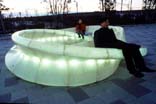 Acconci Studio. Moebius bench, Fukuroi City, Japan, 200-01. Translucent fiberglass, fluorescent light. 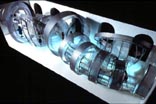 Acconci Studio. MAK Design Shop a store of rotating rings: products on the move, Oesterreichische Museum fuer Angewandte Kunst, Vienna, Austria 2001. Acrylic panels, lights, motors, steel. Exterior view of model. |
I
turned to architecture because it is the art of daily life: we are all
architecturally conscious, although we may not be aware of it, and even
though we are familiar with it because it oppresses us, it is still
a form of art that is mastered through daily experiences. You were almost always physically present at your performances or installations, watching the public as they experienced the situations you created; but when your production became more openly of an architectural kind, you were there almost like an outsider, a stranger. This marks an important change because space acquires a status of its own, one that is far away from your physicality. Actually, when you work with architecture, you reach a point beyond which you cannot go, your work is completed and space exists out of its own status. This separation between the represented spatial environment and my physical presence began already with the installations because, after designing the environment, my voice remained, almost like some sort of residue of the spatial composition. Therefore, the real space, the one created for the public, becomes a kind of virtual space for the designer who, at this point, can only venture hypotheses. Through your productions you analyzed the notion of home, room, environment, critically pointing out that architecture is also a commodity; you tried to overturn the rules governing the consolidated use of space. |
|||
| Architects
do exactly the same thing: they seek among known typologies that which
has the potential to be innovative, they distil features that need to
be reassessed, changed or eliminated, such as for instance certain consolidated
social or spatial conventions. Manipulation, deformation, overturning,
these are all ways of acting in the field of design. Your works involve the public directly, making the people interact with the space, while architects often conceive environments that are fascinating but extremely self-referential, quite distant from the casual use the unaware, intrusive public makes of them. When we develop projects at the studio, we think of space as of an opportunity for the public to do things, for people to perform activities; rather than a shape in itself, it is a place that can host different kinds of social uses and meanings. It is the people who create the space of artistic performance and it is precisely because of this that the little three-dimensional models of our projects tend not to be abstract: they must help us to understand how the project relates with other spatial entities, and not to understand the abstract nature of the project itself. This procedure breaks with the choices of many contemporary architects who seem to prefer very abstract spatial representations, created by means of sophisticated graphic techniques, which, however, estrange the project into a world of its own. |
||||
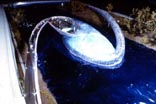 Acconci Studio. Island on the Mur, Graz, Austria, 2001. Steel, glass, polycarbonate, water, light. |
There
is something in computer-generated space that keeps it from being sufficiently
specific; it certainly allows you to be in a fluid-like condition, albeit
one that is made up of specific points... ...generated by computer automatism. |
|||
| When
you think of these environments as of possible spatial built entities,
space cannot be imagined only in exquisitely abstract terms: you need
to take into account everything that defines and articulates the space,
you need to look at reality in its broader, public, urban dimension.
In any case, the final project may still not be as interesting as expected
because the points of contact between the various parts of the building,
the tectonic joints, are always visible and cannot be ignored, as if
they weren't there. This is a fact which we have to deal with, although
we don't always know how. This remark points out another interesting aspect of architecture, namely that it is something that can be designed but not controlled completely. What is generated is a kind of imponderability. Indeed, even though it is you who are designing the space, you cannot expect to control it totally until the end. One thing that is fascinating about architectural processes is that, no matter what the starting situation is like, you always end up being obsolete, out of phase, because architecture takes time and cannot be constructed at once; on top of that, during this process, the ways and relations between things change. After all, between the birth of a project and its materialization there is a development process leading to the relativization of the initial hypotheses and notions. Perhaps it's a bit like starting a new project, or at least developing it, enriching it with more viewpoints. Looking back to your previous productions, one finds again that special interest in bodily entities and functions (skin, biting, etc.) and, at the same time, the desire to involve the public in actions and movements which are of various kinds but still similar to psycho/physiological mechanisms. Our point of departure is often the notion of activity and transformation which bears in itself the awareness of past and future. Many of our works are expressed by way of actions such as peeling, twisting, turning upside down, turning inside out, and unfolding. EC And what about your recent works?  Acconci Studio. Light beams for the sky of a transfer corridor, San Francisco International Airport, USA 1997-2001. Fluorescent light, acrylic panels, plastic laminate, steel, sheet rock, telephones. And what about your recent works? |
||||
| In
September we inaugurated an exhibition of our works from 1980 to today;
actually, we could have fixed an earlier starting date but the year
1980 was a milestone: it was the time when we designed the Instant
House, a kind of architecture that anyone could build by him/herself,
using any type of tool or means. The exhibition includes many models
and a host of designs and it is structured like an installation, using
wire mesh as an element that both separates and supports, thus becoming
a wall, a screen or a covering; our idea was to choose an element that
was transformable and re-shapeable in order to use it in different ways
in the various galleries where the exhibition was being held. More recently, we have just finished adapting the home of a modern art gallery manager and we are now designing an exhibition space in Manhattan for that same person. In this case, too, we tried to create a space that was continuously adjustable, re-shapeable, made up of a series of extensible metal mesh barriers which are sometimes walls and then ceiling, separating the private area from the public one without becoming a fixed barrier but rather a re-shapeable boundary. This kind of project is very similar to the type of artistic/architectural works we were talking about before, the ones where a person builds the space by him/herself using various kinds of mechanisms, means and tools. The use of the metal mesh offers the possibility to hang practically anything anywhere without having to decide beforehand where to place hooks or drill holes. Everything is moldable and foldable, so that by making a single fold at a given height one can create, if necessary, a stand for a piece of sculpture while, by making a lower loop, you create a seating and so on. I don't know whether or not we succeeded in our intent but it certainly was a starting point to develop our study on the total use of space. This theme was present also at the end of the Eighties in the space created for the Storefront in New York (exhibition area in the shape of a long, narrow wedge, with external concrete walls that revolved horizontally and vertically on pivots, removing every distinction between the space of the street and the space of the gallery; in collaboration with architect Steven Holl editor's note) and in the design of the prototype of an extensible home trailer presented in Vienna. These themes return over and over again because of a recurrent idea: designing freedom. But the physical reality of modern mechanics does not offer the flexibility that most designers would like to produce, there is always a certain amount of stiffness. |
||||
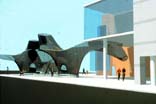 Acconci Studio. Project for corner plaza, center for the performing arts, Memphis TN, USA, 2001. 2-way mirror, steel, light. |
In
fact, you may be able to bend a wall, but what happens when you want
to "roll it up"? As a matter of fact, space is interchangeable but only
according to the rules we ourselves have set; in short, it is a
bit like "supermarket freedom", you may buy anything provided it is
in stock. But then, the public is not so passive, especially now that
it is possible (partially) to use computers and the Web to modify the
news published in papers or, an even easier task, to mix music. Do you feel that this use of the media is a form of "expansion" of democracy? I believe it is a starting point. At the same time, however, there's this misunderstanding whereby the concept of public realm is considered as something different from the private realm; in the Web, public, private and individual are all one thing. |
|||
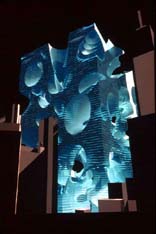 Acconci Studio. Project for a new World Trade Center, New York, 2002. Exterior view. |
It
is really very difficult to set the boundary between these different
spheres, because when you are in the Web, you simultaneously experience
both dimensions, that of the individual reading in private, almost as
if he/she were reading a book (the monitor) and that of the person who
is a public element making up the Web itself. You live in a constant flow, free of limits, free of roles and time structures. |
|||
| It
is easier to reply to e-mail messages than to write proper letters;
personally, I prefer e-mail because I hate using the phone. Through the e-mail you set up a kind of communication channel that is permanent, direct, unconventional, timeless; a channel that is always in stand-by mode and never blacks out. I'd like to design a virtual city with neighborhoods and streets that exist only on the Web. We have always designed places where people go to, but we'd like to design places that can be taken away, on your back, on your head or inside yourself. 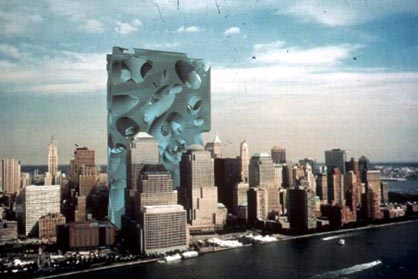 Acconci Studio. Project for a new World Trade Center, New York, 2002. Photomontage. Let's talk about the exhibition organized in New York by the Max Protech gallery and featuring the works produced by artists and architects for Ground Zero, the empty space left after the World Trade Center destruction. Many artists seem to have missed this opportunity to review urban reality in a broader sense. The meaningfulness of such an event, so destructive and yet at the same time so "present" on TV screens, seems to have produced very few changes in the notion of public space as a physical and conceptual place. Many participants designed mostly new towers. 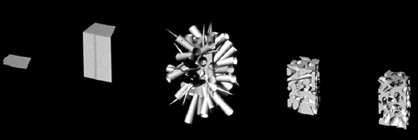 Acconci Studio. Project for a new World Trade Center, New York, 2002. Diagrams. Actually we too designed a tower. But what was interesting was the way we imagined a series of projects which we later decided not to realize; it is precisely the relation between what we had in mind and what we developed that, to me, was the most important thing in the whole operation. One of the starting points was to consider Ground Zero as a contextual margin, the edge on which to build something that would have flowed outwards, into the city. We wanted to set up a kind of network that would have wrapped up and crossed the urban structure. Eventually, however, we decided in favor of an image because we couldn't develop the idea of a net in real terms. In a way, we felt the need to contribute our idea to the theme even though time was short. We didn't want to use our imagination alone and we also analyzed issues such as ownership rights and so on. So we decided to fill the site with an architectural structure and then to bore a hole in it, a kind of pre-exploded tower. In a way, I must admit that we picked the easiest solution. What are you working at now? An artificial island on a river in Graz, Austria, to be completed by 2003, there will be a theater, a café and a playground; the dome, the roof of the café, can change shape to become a hollow structure containing the theater, while the interstitial space is the playground. We are also busy with the Design Store for the Museum für Angewandte Kunst, a kind of ribbon made up of rings that follow one another, crossing the building from inside to outside; then we're working at a hill near a meadow with contemporary artworks in Verzegnis near Udine for the Marzona collection. In New York we are designing a new underground station in Coney Island. This project is important for us because its initial construction phase has already begun; usually, precisely because we are viewed as artists and not as architects, we are allowed to intervene only when the majority of the decisions have already been made and everyone expects us to take care of the folly. |
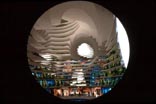 Acconci Studio. Project for a new World Trade Center, New York, 2002. Interior view. |
|||
| Si ringrazia per la traduzione The Office, Trieste. | ||||
| >
ACCONCI STUDIO > ELENA CARLINI: ACCONCI STUDIO. THE ISLAND IN THE MUR |
||||